If you’re after a soothing at-home massage, then getting a handheld massager is the next step. But don’t just grab the first one you see. The key to making the most of this health investment is to know how to choose a massage gun.
When choosing a massager, start by trimming down your options based on the product factors that matter to you. These could include massage quality, price or battery life. Then, evaluate your top choices using other features like design, portability or brand.
However, a thorough evaluation of a massage gun requires some understanding of its specs and relevant terms.
So, here’s a list of things discerning buyers like you need to know when getting one.
Massage Power and Quality
This one is perhaps your top deciding factor when choosing a massage gun, so I decided to highlight this first.
And three things matter when assessing massage power and quality: stall force, stroke length and speed.
Let’s define each.
Stall Force
The stall force, also called percussion force, is the pressure a massage gun can produce before it stalls or stops.
The higher the stall force, the more potent the massage therapy. And it is measured in kilograms or pounds.
Small and softer muscles often require a lower stall force than large, resilient muscle groups.
So, deciding which stall force is best depends on your target muscles.
This table explains this factor further.
Here, note that moderate massage stall force is the industry standard and suits most gym-goers.
| STALL FORCE RANGE | MASSAGE QUALITY |
| 9 to 14 kg (20-30 lbs) | Soft massage |
| 14 to 23 kg (30-50 lbs) | Moderate massage |
| 23 kg or more (50 lbs or more) | Intense massage |
Imagine this: a massage gun with a stall force of 9 kg (20 lbs) can automatically stop when pushed with your palm.
If most of your target muscles are stronger than your hand, a massage gun with a higher stall force might be a better option.
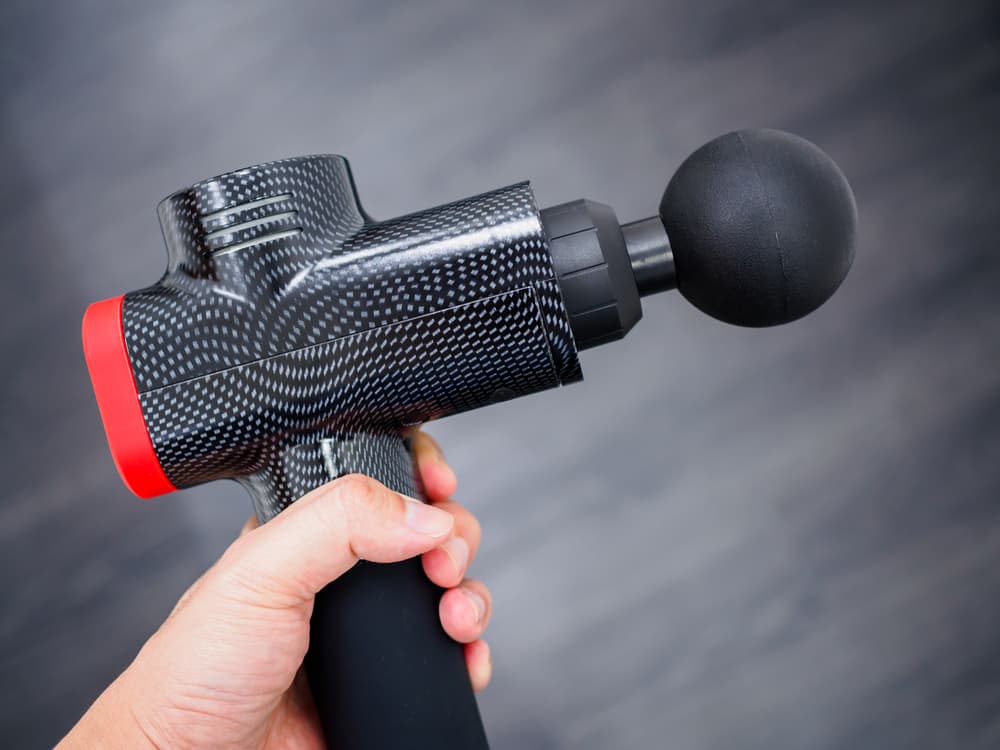
Stroke Length
The stroke length, also called amplitude, refers to the distance the massage gun head travels as it moves back and forth.
The longer the stroke length, the deeper the percussive therapy. And it is measured in millimetres.
If you cannot tell the difference between stall force and stroke length, try to use a human boxer’s arm as a visual example.
The stall force is the power and pressure of the punch that a boxer’s arm makes.
On the other hand, stroke length represents the boxer’s reach.
That means a longer reach (or stroke length) is ideal for a more targeted hit on the muscles.
Here’s a table for further comparison. Note that the deep tissue massage stroke length is the industry standard.
| STROKE LENGTH RANGE | MASSAGE QUALITY |
| 10 to 12 mm | Soft tissue massage |
| 13 to 16 mm | Deep tissue massage |
| 17 mm or more | Intense massage |
Generally, well-built people should use a massage gun with a higher stroke length.
Users with softer muscles would likely benefit from short-amplitude massages.
But that is not always the case.
Some people with undeveloped muscles choose a massage gun with a higher stroke length to reach areas like the back and shoulders.
A massage gun with a longer reach is easier to hold and position without straining your arm or wrist.
Speed
Massage gun speed indicates how fast the head oscillates. And there are two factors to consider when looking at massage speed.
One is the number of speed settings or options. The other is the speed range, often measured in percussions per minute (PPM).
PPM tells you how many times a massage gun head can hit your body in 1 minute.
So, lower PPM gives a gentler massage, while higher PPM hits your muscle at shorter intervals.
Speed level settings vary from model to model. Some have 5, others over 10.
But in most cases, it is not the number of options that matters but the speed range each level offers.
So, a 10-speed option device with a smaller range may not be for you if you enjoy switching from soft to intense massages.
A massager with a standard speed range of 1700 to 2400 should be a good starter.
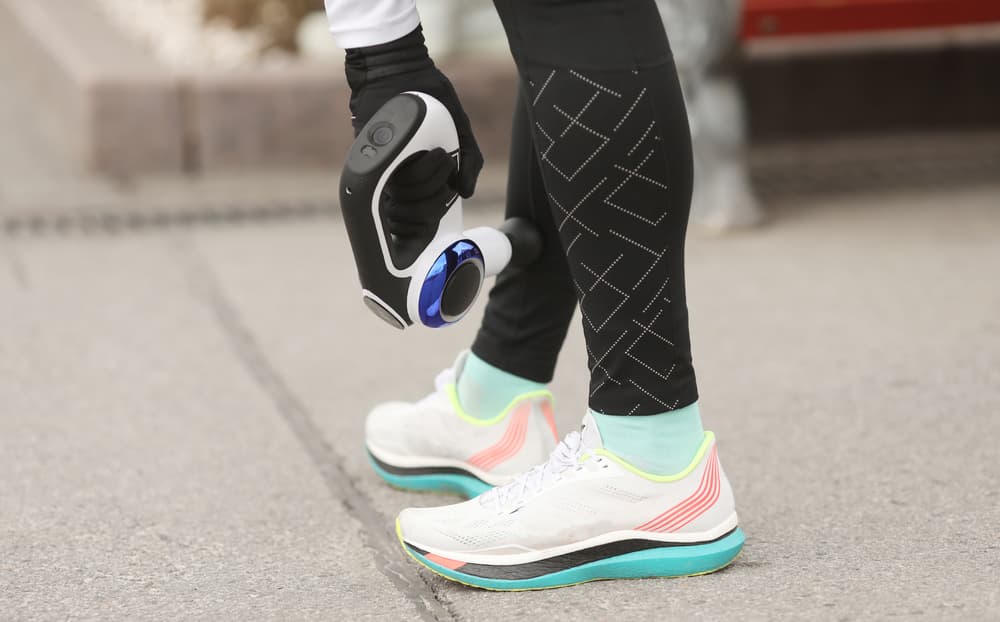
Design
There’s no standard to follow when you choose a massage gun based on its design.
You can go traditional or choose the modern and sleek one based on preference.
But one crucial factor you should associate with design is the ease of use or ergonomics.
You see, the shape and style of a massage gun can affect the size of its handle or the power button position.
All these can make or break your overall massage experience. So, always aim for balanced aesthetic and practical aspects.
Some of the typical massage gun designs you’ll see are the following:
- Standard. These models are typical gun-shaped devices with a straight handle or grip. The RENPHO and the Bob and Brad C2 massage guns are examples. As it is the most common design, you’ll likely have more options, especially on price range.
- Triangular. The Theragun percussive massagers have this recognisable triangular handle. Massage guns with the same design are limited, though. But it is very ergonomic as you get multiple grips and a rotating arm, allowing you to massage hard-to-reach areas comfortably.
- Jigsaw. This one has a parallelogram-shaped handle. It looks like a combination of the standard and triangular designs. It’s also the most ergonomic of all massage gun types but rare.
Usage and Performance Features
What kind and how many massage heads do you need? How heavy should your massage gun be? Do you prefer a quiet device or one with a long battery life?
These are some usual questions you should ask yourself when choosing a massage gun.
Let’s answer them one by one.
Attachments
Most massage guns come with at least four interchangeable attachment heads with the motor unit.
The most common would be the foam ball, flat, fork and bullet heads.
Each has a different purpose. Some brands also offer attachments that you can purchase separately.
It’s a more cost-efficient option rather than spending on an expensive massage with lots of extras you don’t want or need.
Other manufacturers also design unique attachments, adding to the percussive therapy variety.
For instance, the Hydragun Atom Mini has metal-tipped heads that you can chill for a cold massage.
Make sure to choose a massage gun with a set of attachments that you’ll use.
Check if the carrying case is of good quality, too.
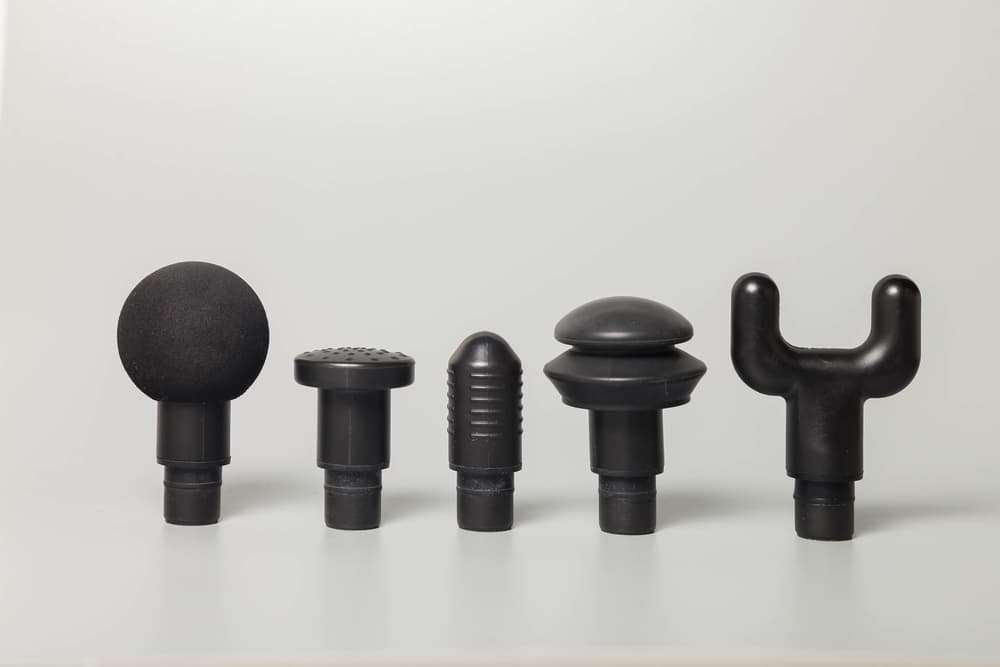
Size and Weight
Most people choose a massage gun that’s small and lightweight. It’s quiet and easy to take anywhere, plus it doesn’t take up space.
Size and weight factors are crucial if portability matters to you.
However, keep in mind that light isn’t always right.
Smaller percussive guns, or those less than a kilo, usually have lower massage power and battery life.
They may also have limited features. So, getting a mid-size device is probably best if you’re after general use.
Battery Life
The battery is the heart of your massage gun. And so, its power should match your massage needs and preferences.
For instance, if you plan to use it often, choose a massage gun that can do an hour-long session even without recharging.
A massage gun that you can recharge with a USB-C cable should be perfect if you want to take a fast-charging device anywhere.
Generally, a good massager has about 2-3 hours of battery life.
But remember, battery life can be affected by speed setting, higher stall force and other extra features that eat up energy.
Noise
If you think a quality massager should not disrupt others when in use, then make sure to check its noise level.
Most massagers generate a humming sound at 50 to 70 decibels (dB) (CDC 2022).
It is a pretty tolerable range, considering that 60 dB is the same level as people having a normal conversation.
Here’s a reference you can use when comparing massage gun noise levels.
| NOISE LEVEL | SOUND DESCRIPTION |
| 40 dB and below | Super quiet, like a whisper or refrigerator hum |
| 50 to 60 dB | Quiet, like a normal conversation or air conditioner |
| 70 dB | Standard, like a dishwasher or washing machine |
| 80 dB and above | Loud, like city traffic noise while inside a car |
Based on this table, a massage gun with a noise level higher than 70 dB may not be ideal for public or shared spaces.
But a quiet massager, like the 50-dB Hydragun Massage Gun, is perfect anywhere without drawing unnecessary attention.
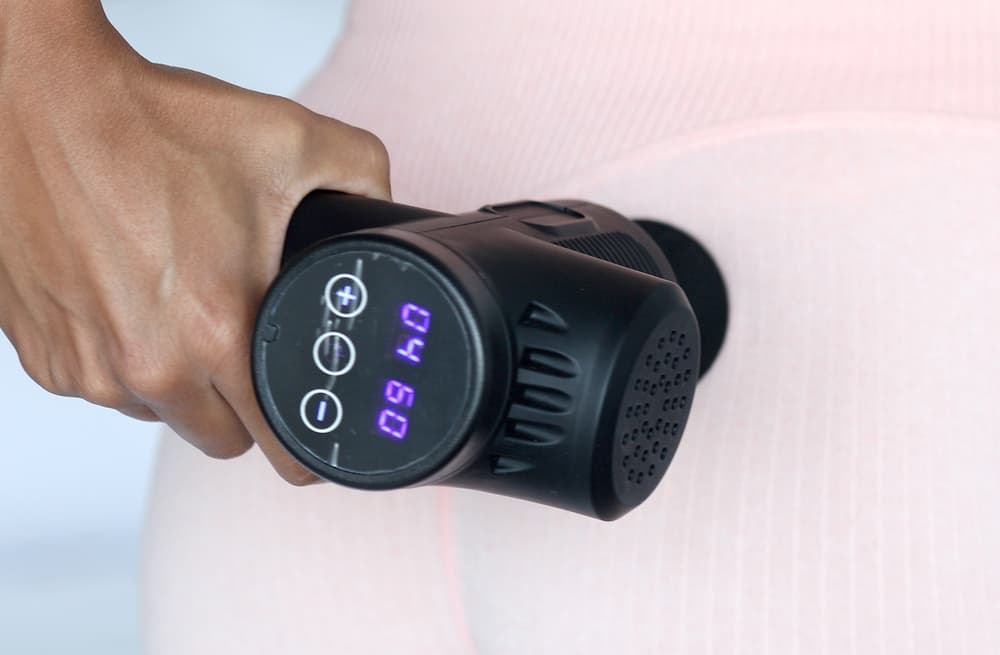
Special Features
Most percussive massagers share pretty much the same features.
Extras, like app compatibility, Bluetooth or Wi-Fi options, auto shut-off, heat therapy and pressure sensors, make other models stand out.
These features sound great, but they also affect the cost of the device.
So, when choosing a massage gun, determine whether you need these add-ons first.
More importantly, prioritise features that contribute to better overall health and massage experience.
Brand, Warranty and Reviews
I put these three factors in one section because you have to check them together.
Specifically, these are what you should consider when you want to assess the durability of a massage gun.
It’s always best to go for a reputable brand when getting a massager.
And most brand manufacturers include a 1-year warranty with their products, which is good. Some even offer a lifetime warranty for repair.
However, aside from the warranty coverage, it also helps to find out about the ease of warranty claim, especially when buying a massage gun from overseas.
Questions like “is there a local office for this brand” or “will I shoulder the shipping cost when sending back a defective item” should be addressed.
You can do this through website enquiry, either by chat or email. Reading customer reviews also helps.
Ideally, use the brand and warranty as your deciding factors, then check ratings and feedback to verify your choice.
Price
The number of massage guns in the market can be overwhelming.
But a quick way to narrow your options is to set a specific budget.
In Australia, a massager can cost between $70 and $700.
It’s a wide price range, and that’s because massagers have varying features.
| PRICE RANGE | PRODUCT RANGE |
| Budget: below $100 | Mostly from overseas brands, has average features, best for occasional users |
| Mid-range: $100 to $300 | Offers price and performance balance, includes mini massage guns, best for most users |
| High-end: above $300 | Made by top brands and industry leaders, professional-grade quality, with customisation options, best for athletes and users needing heavy-duty therapeutic devices |
The safest option is to choose a mid-range portable massage gun.
Products within this price category should give you quality features and performance without spending too much.
But then again, there’s nothing wrong with getting a budget or high-end model.
You should, however, match the price and quality of your choice with your purpose.
For instance, buying a premium massager may not be practical if you are a hobbyist.
An expensive option is more suitable for those who will use it to improve their athletic performance or relieve health conditions.
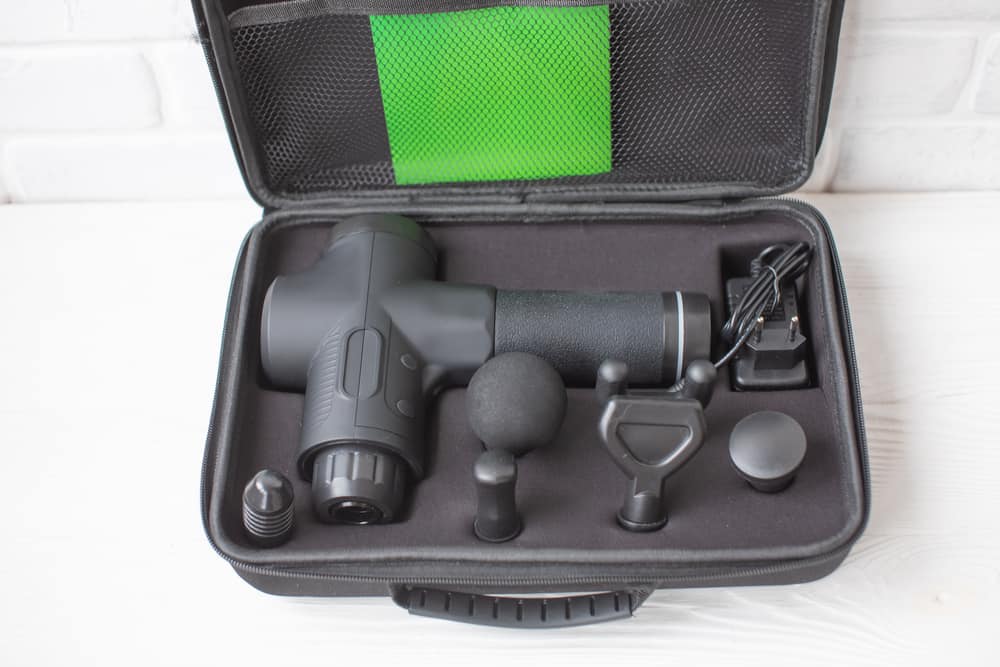
Conclusion
The right way to choose a percussion massage gun is to go beyond watching viral videos and finding out what’s trending on social media.
Go the extra mile and read product reviews and buying guides. Compare items based on brands, features and prices.
Better yet, get hands-on experience when you can.
It’s easier to decide which one to buy when you can see, feel and hear the actual product.
Related Questions
1. How do I maintain a massage gun?
Regular cleaning, safe storage and correct charging habits are crucial for proper massage gun maintenance. Some massage gun models may occasionally need lubrication and battery replacement, too. Make sure to read the manual’s instructions for this. Also, choose your handheld massager wisely, and pick one from a reputable brand with good after-sales service.
2. What are the benefits of a massage gun?
Massage guns provide muscle relief, help with injury recovery or prevention, and promote overall wellness. Athletes also use a percussion massager to improve their performance. Specialists find this tool beneficial in treating cellulite, too. These devices are perfect for people who need a relaxing home massage after exercise or a busy day at work.
3. How should I use a massage gun for optimum results?
Start with reading and understanding the product manual. Learn how to position the device to target the correct muscle group without straining your arm. It also helps to know the best time to use the massager when working out. Lastly, follow the recommended percussive massage time limit to avoid going overboard.
- What Are the Advantages and Disadvantages of Folding Treadmills? - 11 March 2025
- Can You Use a Massage Gun When Pregnant? - 10 March 2025
- What is the Best Pre-Run Food? - 6 March 2025
